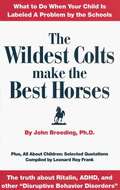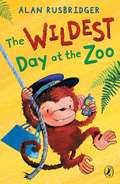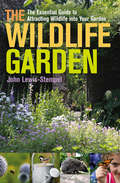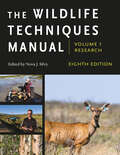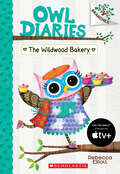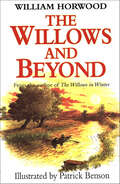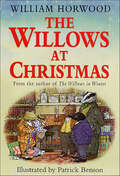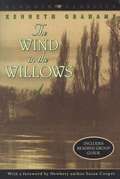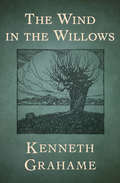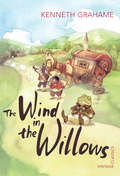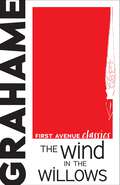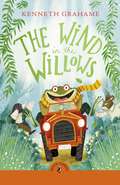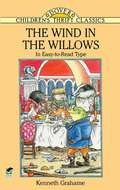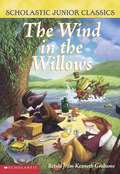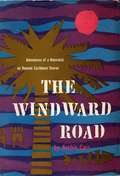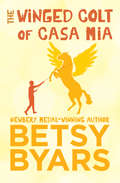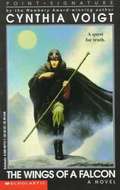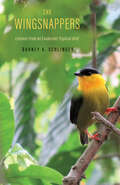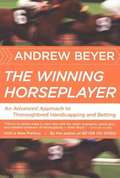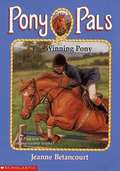- Table View
- List View
The Wildest Colts Make the Best Horses
by John BreedingDr. Breeding presents evidence that we are drugging our children, particularly our young boys, bor behavior that we used to consider normal but now label as problem behavior. He postulates that we are abusing our children with drugs like Ritalin and should welcome rambuntious bahavior in our young children as it represents creativity and the best in normal development.
The Wildest Day at the Zoo
by Alan RusbridgerThe loveable animals and their keepers at Melton Mowbray Zoo are back! Everyone has recovered from the disastrous weekend when the heating broke and Mr Pickles, the zoo director, asked all the keepers to take their animal home for the weekend. In fact, so much so, that a feeling of nonchalence pervades - the animals have been teamed with the same keepers for years and quite frankly it's become rather boring. So. in a bid to liven things up, the keepers decide to swap animals for the day and, as you can imagine this makes for some lively antics!Told in Alan's inimitable dead-pan voice this is another very charming and extremely funny story brought to life by Ben Cort's hugely imaginative illustrations.
The Wildlife Detectives: How Forensic Scientists Fight Crimes Against Nature
by Donna M. Jackson Wendy Shattil Bob RozinskiSlaughtering elephants for their ivory; shooting bears for their gall bladders; capturing sea turtles for soup. In the name of vanity, fashion, and greed, man stalks and kills wild animals -- and gets away with it, even when it is clearly against the law. But now scientists have a way to catch and convict poachers. In a laboratory in Ashland, Oregon, they analyze clues to link suspects to crimes. In words and pictures, this book tells a poignant story and reveals how science can indeed save the day.
The Wildlife Garden
by John Lewis-StempelWith the erosion of native wildlife habitats, gardens increasingly provide an invaluable source of food and shelter for Britain's fauna and flora. The Wildlife Garden is the essential guide to attracting birds to your bushes, butterflies to your buddleia and a whole array of other creatures into your garden - even if you only have a window box. Whether you just want to make an existing family space more wildlife friendly or go the whole hedgehog and turn your back garden into a mini nature reserve The Wildlife Garden will show you how to do it. There is full information on what plants are best for wildlife, on how to make refuges for insects and homes for bats, on making a pool for frogs, all whilst adding scent and colour to your surroundings.
The Wildlife Garden
by John Lewis-StempelWith the erosion of native wildlife habitats, gardens increasingly provide an invaluable source of food and shelter for Britain's fauna and flora. The Wildlife Garden is the essential guide to attracting birds to your bushes, butterflies to your buddleia and a whole array of other creatures into your garden - even if you only have a window box. Whether you just want to make an existing family space more wildlife friendly or go the whole hedgehog and turn your back garden into a mini nature reserve The Wildlife Garden will show you how to do it. There is full information on what plants are best for wildlife, on how to make refuges for insects and homes for bats, on making a pool for frogs, all whilst adding scent and colour to your surroundings.
The Wildlife Gardener: Creating A Haven For Birds, Bees And Butterflies
by Kate Bradbury Julie WatsonCreate wildlife habitats and attract birds, bees, and other creatures to your very own garden: “A must-have for any gardening library.” —Gardeners World Filled with beautiful photos, this book is a practical guide for anyone who wants to make a home for wildlife in their garden—even if they don’t have a lot of space. Divided into sections on shelter, food, and water, it includes: *advice on the best nectar and pollen plants to grow *dos and don’ts of bird feeding *information on organic methods of pest control *ten projects—with step-by-step pictures—that will help encourage wildlife, such as creating a bumblebee nester, making a green roof, and building a hedgehog box Also included is a mini field guide, which will help you identify the birds and other creatures you’re likely to spot in your garden. The Wildlife Gardener gives tips on particular species, explaining what to look out for and how to cater for specific birds, mammals, bees, butterflies, moths, and pond life. “A joyous book.” —Alan Titchmarsh, author of My Secret Garden
The Wildlife Techniques Manual: Volume 1: Research. Volume 2: Management.
by Nova J. SilvyThe #1 selling wildlife management book for 40 years, now updated for the next generation of professionals and students.Since its original publication in 1960, The Wildlife Techniques Manual has remained the cornerstone text for the professional wildlife biologist. Now fully revised and updated, this eighth edition promises to be the most comprehensive resource on wildlife biology, conservation, and management for years to come.Superbly edited by Nova J. Silvy and published in association with The Wildlife Society, the 50 authoritative chapters included in this work provide a full synthesis of methods used in the field and laboratory. Chapter authors, all leading wildlife professionals, explain and critique traditional and new methodologies and offer thorough discussions of a wide range of relevant topics. To effectively incorporate the explosion of new information in the wildlife profession, this latest edition is logically organized into a 2-volume set: Volume 1 is devoted to research techniques and Volume 2 focuses on pragmatic management methodologies.Volume 1 describes research design and proper analytic methods prior to conducting research, as well as methods and considerations for capturing and handling wild animals and information on identification and marking of captured animals. It also includes new chapters on nutritional research and field sign identification, and on emerging topics, including structured decision-making. Finally, Volume 1 addresses measurements of wildlife abundance and habitat and research on individual animals.Volume 2 begins with a section on the relationship between research and management including public outreach, described in a context that encourages engagement prior to initiation of management. An adaptive management approach is described as a cornerstone of natural resource management, followed by a section on managing landscapes and wildlife populations. The volume also includes new chapters on ethics in wildlife science and conservation, conflict resolution and management, and land reclamation.A standard text in a variety of courses, the Techniques Manual, as it is commonly called, covers every aspect of modern wildlife management and provides practical information for applying the hundreds of methods described in its pages. This deft and thorough update ensures that The Wildlife Techniques Manual will remain an indispensable resource, one that professionals and students in wildlife biology, conservation, and management simply cannot do without.
The Wildwood Bakery: A Branches Book (Owl Diaries #7)
by Rebecca ElliottEva and her friends are opening a bakery, in the seventh installment of this New York Times bestselling series!Pick a book. Grow a Reader!This series is part of Scholastic's early chapter book line Branches, aimed at newly independent readers. With easy-to-read text, high-interest content, fast-paced plots, and illustrations on every page, these books will boost reading confidence and stamina. Branches books help readers grow!Eva's friend Macy has a little sister who can't fly on her own. So Eva's class decides to raise money to buy her a super-cool flying chair! Half of the class opens a bakery to raise the money. The other half opens a candy store. Soon the owls are competing to see whose shop can make the most money. But they will all need to work together to raise enough money for the special chair. Can Eva get everyone to work as a team?Continue this book series with “Eva the Owlet,” an Apple TV+ original series!
The Willows and Beyond (Tales of the Willows)
by William HorwoodThis stunning continuation by William Horwood follows the further adventures of the four most beloved characters in English literature. In this new tale, we find the loyal companions approaching the autumn of their lives, reflecting on their many escapades and preparing to hand over River Bank to the next generation. When the future of the home they know and love suddenly comes under threat, all of the creatures, young and old, must rally together. Enriched once again by the outstanding illustrations of Patrick Benson, The Willows and Beyond is another captivating story for audiences and imaginations everywhere.
The Willows at Christmas (Tales of the Willows)
by William HorwoodThe fourth enchanting addition to Kenneth Grahame's classic The Wind in the Willows - with the delightful illustrations of Patrick Benson.The twelve days of Christmas are fast approaching and Mole is planning to enjoy every one of them with his River Bank friends. So when the normally cheerful Toad despairs at the arrival of Mrs. Ffleshe, an impossibly rude houseguest who every year sets out to protect Toad from overindulgence, Mole must do something about it. But the plan he hatches with Ratty, Badger, and Otter goes horribly wrong. With the prospect of spending Christmas in jail, Mole will have to work hard if he is to salvage some Christmas spirit for his friends.The Willows at Christmas is the crowning achievement of William Horwood's enchanting sequels to Kenneth Grahame's The Wind in the Willows. The new story is set just after the original, but before Horwood's critically acclaimed The Willows in Winter. It will give pleasure to the countless readers around the world who have reveled in each new work. Merry Christmas!"Lovers of The Wind in the Willows will feel at home and will laugh a lot with sheer pleasure." - The Times
The Wind in the Willows
by Kenneth GrahameThe escapades of four animal friends who live along a river in the English countryside--Toad, Mole, Rat, and Badger.
The Wind in the Willows
by Kenneth Grahame Susan CooperConsidered a masterpiece of contemporary fiction by many, this charming idyll about Toad, Rat, Mole, and Badger represents the best of British whimsical fantasy. Kenneth Grahame's creatures endearingly share friendship (and tea) alongside the River, as together they face the turmoil of modern life and the pleasures of Arcadia.
The Wind in the Willows
by Kenneth GrahameThe classic story of Mole, Rat, Toad, Badger and the wonderful adventures they share As spring begins to bloom across the countryside, so too does Mole’s desire to leave his underground home and venture into the wilds above. His journey delivers him to the banks of a river—the first Mole has ever seen—and to the blue-and-white boat captained by Rat. Their camaraderie sparked, Mole and Rat continue into the Wild Wood, meeting up with the cantankerous Badger and the impulsive Toad. No stranger to calamity, Toad and his reckless habits—including a tendency toward spectacular car crashes—will get the four friends into heaps of trouble, but their steadfast loyalty to one another always sees them through.The Wind in the Willows is a charming, unforgettable ode to friendship and one of the most cherished children’s stories of all time. This ebook has been professionally proofread to ensure accuracy and readability on all devices.
The Wind in the Willows
by Kenneth Grahame"Ho! ho! I am the Toad, the motor-car snatcher, the prison-breaker, the Toad who always escapes!" Tired of spring cleaning, Mole ventures above ground into the warm sunshine, and happens upon his friend Ratty. Together they picnic on the sparkling, burbling river, brave the sinister Wild Wood in wintertime to visit the bad-tempered Badger, and take to the open road in a caravan with dear, silly old Toad. But when Toad's attention turns to motor cars, his reckless behaviour goes from bad to worse. Badger, Rat and Mole must save their friend from ruin, and Toad Hall from the clutches of the rascally Stoats and Weasels.BACKSTORY: Get outdoors and explore the natural world, and test your knowledge of The Wind in the Willows.
The Wind in the Willows (First Avenue Classics ™)
by Kenneth GrahameSpring has finally arrived, and with it, new adventures. Friends Rat and Mole go on a river cruise or stop by Toad Hall to visit their friend Toad. Toad is a friendly fellow, but he obsesses over the latest fads. From boats to horse-drawn caravans, his adventures get bigger and bigger. When Toad discovers the shiny, fast motorcar, Mole and Rat have more on their hands than they can handle. The two team up with Badger to save their friend…but more trouble awaits them than they could possible imagine. Scottish author Kenneth Grahame wrote this tale of friendship and forgiveness, which was first published in 1908 in the UK. This is an unabridged version of the 1913 edition, with illustrations by Paul Bransom.
The Wind in the Willows (Puffin Classics)
by Kenneth GrahamePuffin Classics: the definitive collection of timeless stories, for every childRediscover the Puffin Classics collection and bring the best-loved classics to a new generation - including this edition of The Wind in the Willows complete with a charming new cover.Spring is in the air and Mole has found a wonderful new world. There's boating with Ratty, a feast with kindly Badger and rumbustious fun with that reckless ruffian, Mr Toad of Toad Hall. But deep in the Wild Wood the villainous weasels lurk, intent on causing trouble. . .
The Wind in the Willows: In Easy-to-Read Type (Dover Children's Thrift Classics)
by Kenneth GrahameBeloved classic of children's literature recounts the antic adventures of an engaging assembly of animals who are its central characters: the shy but curious Mole, the extremely personable Water Rat; Badger, a philosophical recluse; and pleasure-seeking Toad of Toad Hall. Newly abridged, with 31 illustrations.
The Wind in the Willows: The Junior Novel
by Kenneth Grahame Ellen MilesThe escapades of four animal friends who live along a river in the English countryside--Toad, Mole, Rat, and Badger.
The Windward Road: Adventures of a Naturalist on Remote Caribbean Shores
by Archie CarrThe Windward Road, published in 1956, made history. When Archie Carr began to rove the Caribbean to write about sea turtles, he saw that their numbers were dwindling. Out of this appeal to save them grew the first ventures in international sea turtle conservation and the establishment of the Caribbean Conservation Corporation.In addition to sea turtle biology, Carr recorded his general impressions, producing a natural history sprinkled with colorful stories.
The Winged Colt of Casa Mia
by Betsy ByarsThere&’s no such thing as a colt with wings—is there?When Charles arrives at his Uncle Coot&’s Texas ranch from back East, he&’s sure that books have taught him everything he needs to know about horses. He wants to prove he&’s a cowboy just like his uncle, a retired movie stunt rider, who knows Charles is out of his element. But when a neighbor&’s mare gives birth to a miraculous colt with wings, Charles and Coot realize that they both have much more to learn. They grow to love the colt, named Alado, or &“Winged One.&” Still, it&’s no easy feat caring for a mythical creature, especially when it can fly. Can Charles and Coot protect Alado—and each other? This ebook features an illustrated biography of Betsy Byars including rare images from the author&’s personal collection.
The Wings of a Falcon (Vol. 3 of The Kingdom Cycle)
by Cynthia VoigtThere was something different about him, he had no name. He showed no emotion, never yielded. And Griff always stood by him, so when he decided to escape, he took Griff with him. 3rd in a loosely-related series.
The Wingsnappers: Lessons from an Exuberant Tropical Bird
by Barney A. SchlingerBirds, hormones, and extraordinary behavior: The story of the tiny but mighty golden-collared manakin of Panama This book is the story of a remarkable bird, the golden-collared manakin (Manacus vitellinus) of Panama. Males of this species perform one of the most elaborate, physically complex, and noisy courtship displays of any animal on the planet. Barney A. Schlinger delves into the specialized neurons, muscles, bones, and hormonal systems underlying the manakin’s unique courtship behavior, creating a rich life-history account that integrates field observations and evolutionary biology with behavioral ecology, anatomy, physiology, biomechanics, and general ornithology. The personal lives of investigators and the natural history of the Panamanian rainforest provide context for this account of the bird's fascinating behavior. Schlinger clearly and approachably explains basic concepts in disciplines such as avian anatomy, endocrinology, sexual differentiation, and the neurobiology of song and aeroacoustics, offering readers a window into the biology of this exuberant bird.
The Winner's Walk
by Nancy Ruth PattersonCase Callahan is determined to make his mark but ends up in terrible failure. Nevertheless, Case comes upon a lost dog that he finds his path to success. This is the perfect story for any child who has struggled to discover his talents and for any dog lover.
The Winning Horseplayer
by Andrew BeyerIn The Winning Horseplayer, Andrew Beyer builds on the strategy of speed handicapping that he detailed brilliantly in Picking Winners by introducing the concept of trip handicapping. Through an unbeatable combination of case studies and lively anecdotes, Beyer shows the smart bettor how to combine past performance data with an understanding of trips, track bias, and pace. This advanced guide to handicapping, which includes a new preface by the author, offers a generous dose of the wit and wisdom that have made Beyer a legend in the sport.
The Winning Pony (Pony Pals #21)
by Jeanne BetancourtLulu missed her pony, Snow White, while she was on vacation. When she returns, Snow White is missing! And worse, she discovers a boy named Charlie has been riding her pony Western style.
